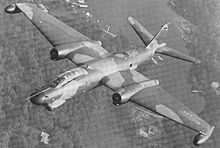| Operation Shed Light | |||||||
|---|---|---|---|---|---|---|---|
| Part of the Vietnam War | |||||||
 Tropic Moon III B-57G aircraft with FLIR and LLLTV in nose | |||||||
| |||||||
| Belligerents | |||||||
|
|
| ||||||
Operation Shed Light was a crash development project in aerial warfare, initiated in 1966 by the United States Air Force to increase the ability to accurately strike at night or in adverse weather. During the 1960s the United States military worked hard to interdict the movement of men and materiel along the Ho Chi Minh trail. The North Vietnamese were experts in the use of weather and darkness to conceal their movement, and understanding the superiority of American air power put their skills immediately to good use. US forces seeking to impede the steady flow of supplies attempted to locate largely static targets during the day with poor results.
The United States Air Force, focused toward nuclear weapons and delivery of such munitions against static strategic targets had spent little effort in expanding its tactical capabilities since the end of World War II. Operation Shed Light sought to rectify this by bringing together improved tactics and technology. The programs were subsequently centered on improved communication and navigation aids for all-weather and night flying, sensor equipment for seeing through clouds, foliage, and darkness, improved equipment and methods for target marking and battlefield illumination, and aircraft and tactics to utilize these developments. In the end, few of the programs would yield applicable results and most of the aircraft developed under its umbrella would largely fall into obscurity. The most applicable developments were those that could be mainstreamed such as the work done on navigation and communication and sensor equipment.
